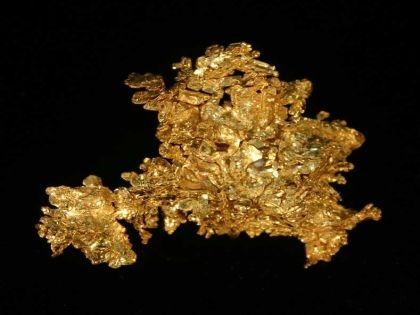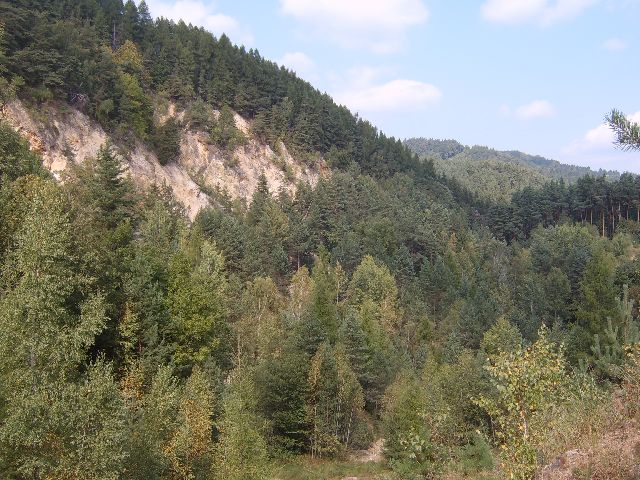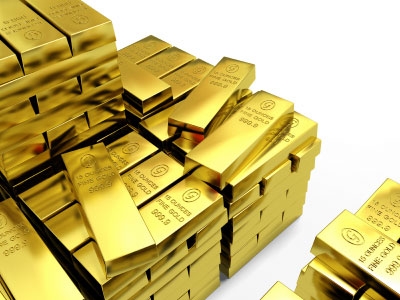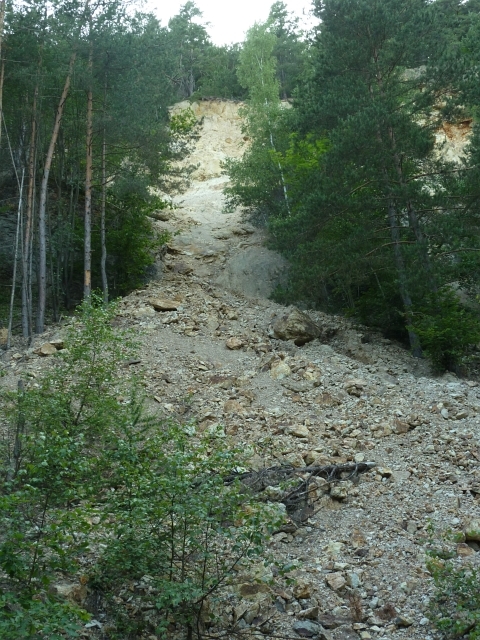Zlato v Sturci
(Gold in Sturec)


Zlato
Zlato
Zlato (lat. aurum) je chemický prvok v Periodickej tabulke prvkov, ktorý má znacku Au a protónové císlo 79. Zlato je ušlachtilý žltý, stály a velmi kujný kov známy už od staroveku. Je elektricky aj tepelne dobre vodivý. V prírode sa vyskytuje najmä v rýdzej forme. Vo svojich zlúceninách sa vyskytuje s mocnostou Au+3 a Au+1.
V horninách sa vdaka svojej inertnosti vyskytuje prakticky iba ako rýdzi kov. Kockový nerast vytvára pliešky a zrná uzavreté najcastejšie v kremennej výplni žíl. Kryštály nie sú hojné, casto mikroskopicky rozptýlené v šedom žilnatom kremeni.
Vyskytuje sa rýdze alebo v zliatine so striebrom (elektrum). Po rozrušení žíl sa dostáva do náplavov odkial sa ryžuje. Najbohatšie svetové náleziská sú v južnej Afrike, na Urale, v Austrálii; okruhliaky zlata (nugety, až kilogramové) v Kanade a na Sibíri. V Cesku sú zlatonosné žily v stredných Cechách (napr. Jílové, Roudný), v Jeseníkoch (Zlaté Hory) a v okolí Kašperských hôr, na Slovensku pri Kremnici, ale aj v západnej casti Malých Karpát.
Zdroj: http://sk.wikipedia.org/wiki/

Sturec
Šturec
Prepadlisko Šturec, ojedinelé v okolitých štátoch, Dlžka približne 700 metrov, šírka 250 metrov, max. hlbka 170 metrov. Severná stena prepadliska je vysoká 80 metrov a je viditelná zo širokého okolia. Toto prepadlisko vzniklo závalom banských diel pri zemetrasení v roku 1443. Pri tomto neštastí zahynulo približne 500 baníkov.
Zahájenie banskej cinnosti v oblasti Šturca sa len predpoklada, nakolko z hladiska geologickéhoto mohla byt len obnažená žilná štruktúra s obsahom zlata. Pôsobením poveternostných podmienok zvetrávala a z horniny sa uvolnovali zlatinky, ktoré splavovala voda a usadzovali sa na dne potoka. Priestor dnešného Šturca mal v tej dobe odlišnú podobu, než ako ho vidíme dnes.
Prvy hladaci zlato získavali ryžovaním z náplav potoka cca od roku 800. Potok ich doviedol až žilným štruktúram, k primárnemu zdroju zlata. Zacali ho tažit so závalov, potom z odkrytých žíl a až následne zacali razit štôlne a šachty.
Odhaduje sa, ze tažba zlata v Šturci zacala už pred rokom 1000 ale zlatý vek rozvoja baníctva a tým i samotného mesta Kremnica je datovaný do 14. storocia až do polovice 15. storocia. Postupne dochádza k poklesu banskej cinnosti jednak vydobytím bohatých ložísk, alebo zaplavovaním štôlní. Úpadok baní pokracoval aj v 16. storocí
Po roku 1918 bane preberá štát. Zhoršenie ekonomickej situácie poklesom cien zlata na svetovom trhu mal za následok ukoncenie tažby zlata v roku 1972.
Zdroj: http://www.slovenskabanskacesta.sk/
Ak chcete logovat túto keš, odfotte sa s GPS (alebo alebo len GPS) v prepadliska Sturec (dobrovolne), ale prosim neuvadzajte fotky na ktorych na sa daju najst odpovede na otazky. Tiež je potrebné zodpovedat nasledujúce otázky a odpovede poslat cez e-mail bud mne cez profil, alebo cez tento link:
- Na koordinatoch EC vidite kammenu dosku, na ktorej je zaciatok a koniec cinnosti v stolni. Uvedte rok ukoncenia banskej cinnosti v stolni.
- Na (WPT1) vidite diery v stene. Su pozostatkom banickej cinnosti s pred vzniku prepadliska. Su to stolne pod povrchom, ktore boli odhalene vznikom prepadliska. Kolko takychto dier v stene vidite a v akej vyske su?
- Na rovnakom mieste (WPT1) najdete este jednu dieru na urovni zeme z ktorej citit prudit studeny vzduch z podzemia. Ake rozmery ma tato diera?
- Na (WPT2) najdete uzavrety vchod do stolne, ktora je dalej zavalena. Aka dlha je tato stolna po zaval?
Keš kludne logujte, nemusíte cakat na potvrdenia správnych odpovedí.
Ak odpovede budú nesprávne, alebo neúplné, bez fotky a pod., budem Vás kontaktovat emailom. Pokial ale Váš email nepríde do 3-och dní po logu, log bez upozornenia mažem.


Gold
Gold
Gold is a chemical element with the symbol Au (from Latin: aurum "gold") and an atomic number of 79. Gold is a dense, soft, shiny metal and the most malleable and ductile metal known. Pure gold has a bright yellow color and luster traditionally considered attractive, which it maintains without oxidizing in air or water. Chemically, gold is a transition metal and a group 11 element. With exception of the noble gases, gold is the least reactive chemical element known. It has been a valuable and highly sought-after precious metal for coinage, jewelry, and other arts since long before the beginning of recorded history.
On Earth, whenever elemental gold occurs, it appears most often as a metal solid solution of gold with silver, i.e. a gold silver alloy. Such alloys usually have a silver content of 8–10%. Electrum is elemental gold with more than 20% silver. Electrum's color runs from golden-silvery to silvery, dependent upon the silver content. The more silver, the lower the specific gravity.
Gold is found in ores made up of rock with very small or microscopic particles of gold. This gold ore is often found together with quartz or sulfide minerals such as Fool's Gold, which is a pyrite. These are called lode deposits. Native gold is also found in the form of free flakes, grains or larger nuggets that have been eroded from rocks and end up in alluvial deposits.
Zdroj: http://en.wikipedia.org/wiki/

Sturec
Sturec
Sturec sink, isolated in neighboring countries, length of approximately 700 m, width 250 m, max. depth of 170 meters. Northern wall of the sink is 80 meters high and is visible from afar. This sink came collapsed section of mining works in the earthquake in 1443rd In the accident, killed about 500 miners.
The initiation of mining activities Sturc only assume, because in terms of geologiy it could be only bare vein structure containing gold. Because of weather conditions it eroded and rocks for release the small pieces of gold, which water carry away and settled to the bottom of the creek. Space of Stures today had at that time a different form than how we see it today.
First gold seekers acquire gold panning in the creek silt around the year 800. Creek led them to vein structures, the primary source of gold. They started to exploit it with caving, then from the exposed veins and then began to lead the shafts and tunnels.
It is estimated that gold mining in Sturec started already before 1000, but the golden age of development and mining and the city itself Kremnica is dated to 14 century until the mid-15th century. Gradually, there is a decline in mining activities both mined rich deposits or flooding adits. Decline of mines continued in the 16th century.
After 1918 the mine assumed by the State. The worsening economic situation decline in gold prices on the world market has resulted in abandonment of mining gold in 1972.
Zdroj: http://www.slovenskabanskacesta.sk/
To claim this cache you need to take a photo of you with a GPS (or your GPS only) in Sturec (optional). You also need to email me (via the link to my profile at the top of the page or to via this link) with the answers to the following questions:
- On coordinates of this EC you can see the stony board, on whitch you can find the beginning and end of activity in the addit. What is the year when the activity in the addit terminated?
- At (WPT1) you can see a few holes in cliff. They are remainings of the mining history before the sink was created. They are old deep addins, which occured when sink created. How many holes you can see and how high they are?
- At same place (WPT1) you can see one more hole at the base level of the rock. There air is blowing from the underground. Describe this hole, (size, direction, whan air is blowing from the hole, etc...)
- At (WPT2) you can see closed adit entrance, which is totally swamped. How long is the tunnel?
Feel free to log this cache. You may not wait for permission to log.
If your answers are not correct, incomplete, without picture etc., i will contact you by e-mail. But if your e-mail is not comming to me without 3 days, I will delete your log without notice.